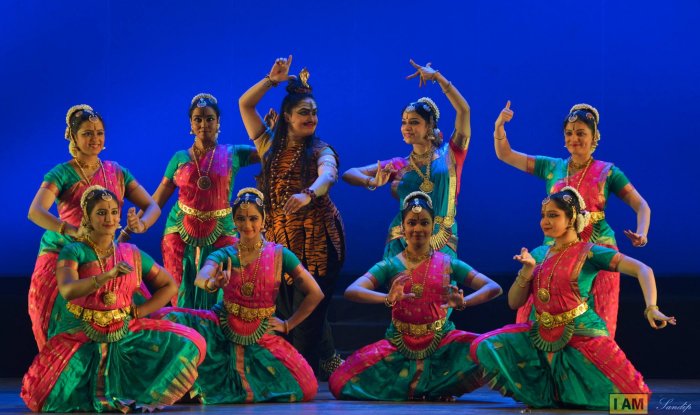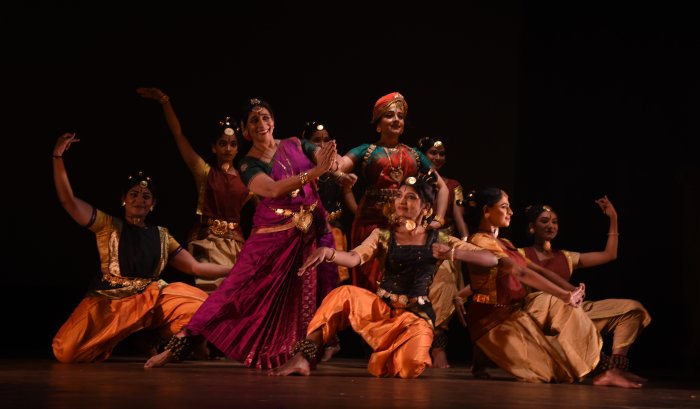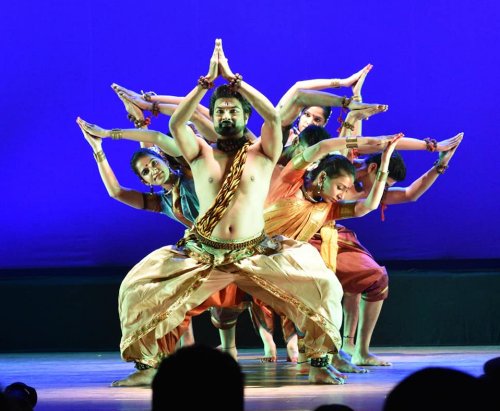
|   |

|   |
 e-mail: leelakaverivenkat@gmail.com Ensemble productions in three dance traditions in Drishti National Dance Festival Photos courtesy: Drishti February 2, 2019 For some reason, Bengaluru's Drishti Art Foundation's annual festival is called the National Dance Festival - which can mean everything or hardly anything. But what held my attention was the Art foundation established by T.M. Vikranth and artiste Anuradha Vikranth, the curator of this event. Visiting the studio with its indoor and outdoor spaces, and having a brief interaction with a few of the students, I was struck afresh with a sense of irony, about Bharatanatyam which despite its many students does not easily attract large audiences for its performances, holding such a fascination for many youngsters qualifying for or already qualified in, other-than-dance professions like medicine, law, teaching, science etc. From a scientist father-in-law with deep fascination for the arts, and a life partner in Mr. Vikranth working round the clock supervising out-of-performance matters, Drishti Art Foundation is more like a family enterprise established by T.M. Vikranth and Anuradha Vikranth with Dr. T.M. Manjunath as chief patron. From what one could make out, the aim of the foundation was not just the Dhristhi or (treating people to) a view of the arts but also educating them by bringing about an awareness through the experience of seeing - leading hopefully, to more discerning audiences.  Drishti Dance Ensemble Water and the Prithvi scenes expand with the well known dance imagery of the birds, the elephant, the deer, the peacock and a striking tree formation by the group. The synchronisation will acquire even greater perfection over repeat performances. Anuradha as Devi enters, the embodiment of tranquility and shanti to the Dhyana Sloka “Arunamkaruna antarangita akshim dhrita pasha anukushapushpa bana chapaam....." describing the goddess as full of compassion, armed with the noose, the goad, bow and arrow of flowers, surrounded by powers as Anima like the rays of one's own self. In the next sequence is a poetic segment showing Parvati desirous of wooing Shiva, but realising that one who has burnt to ashes the handsome Manmatha cannot be won over by mere beauty. Looking with distaste at her own comeliness (nija saundarya vyartham) Parvati gives away her gait to the swan walking crookedly, her zigzagging graceful long tresses to the snake, her smile to the flowers and her eyes to the deer, and finally through meditation wins the love of Shiva, becoming his other half. The concluding scene of Shiva casually downplaying the natural enmity existing among the vahanas of the family members - of Parvati's lion against his vehicle the bull, of his own snake hiding from the peacock carrying son Kartikeya, of Ganesh's mouse which can be prey for the lion of Parvati, with just a wave of the hand seems a bit simplistic. Perhaps the result of having to edit a longer work to fit into the time slot! But it needs to be worked out better for conviction. And then to taper it all off with the Kalidasa line of Vakartha viva sampruktau.... (inseparable nature of word and its meaning) appears almost ironic.  Shambhavi Dance Ensemble Equally effective was the second half of the Kuchipudi segment devoted to Rani Rudramma Devi who, born to a sonless ruler, groomed herself to be an effective swords woman to protect her kingdom. The martial tread, the soldierly stance, the battle exercises for the troops, images capturing the ritual of being anointed ruler and soldier, were all skilfully incorporated in typical Kuchipudi metres in rhythm. This strong flavour of the dance form was brought out through a vibrant performance by Prateeksha Kashi as Rudramma, with the other disciples as part of the group of soldiers. Prateeksha packs her diminutive figure with punch in her movements - her capture of the image of Rudramma's galloping so full of a feel of unleashed energy that it evoked applause each time. And Prabhakar Joshi's lyrics with P. Rama's score in ragas like Vitapi, Hindolam, Revati, Sindhu Bhairavi etc. suited the moods fittingly. Also adding to the total impact were properties like the Sheshnaga hood, very aesthetically designed.  Trikaya Dance Company Using male/female duets, trying simultaneity with a solo dancer in front performing with a group in the hinterland, Rakesh has experimented with the group in many ways. He has used a variety of music to base the dance on. As long as the music does not descend to pedestrian levels and the vocabulary and grammar of movements with Ufli, Topka, the torso Hichak are all seen in the choreographic concerns, without straying into too much of adventurism in the dance, Rakesh's creative attempts will be on the right course. The group of dancers are painstakingly trained and just watching the strenuous movements could make many in the audience break into a sweat. With appetites stirred by this new exposure, the audience response makes one feel that this group will make more visits to Bengaluru. Altogether a well organised festival!  Writing on the dance scene for the last forty years, Leela Venkataraman's incisive comments on performances of all dance forms, participation in dance discussions both in India and abroad, and as a regular contributor to Hindu Friday Review, journals like Sruti and Nartanam, makes her voice respected for its balanced critiquing. She is the author of several books like Indian Classical dance: Tradition in Transition, Classical Dance in India and Indian Classical dance: The Renaissance and Beyond. Post your comments Please provide your name and email id when you use the Anonymous profile in the blog to post a comment. All appropriate comments posted with name & email id in the blog will also be featured in the site. |